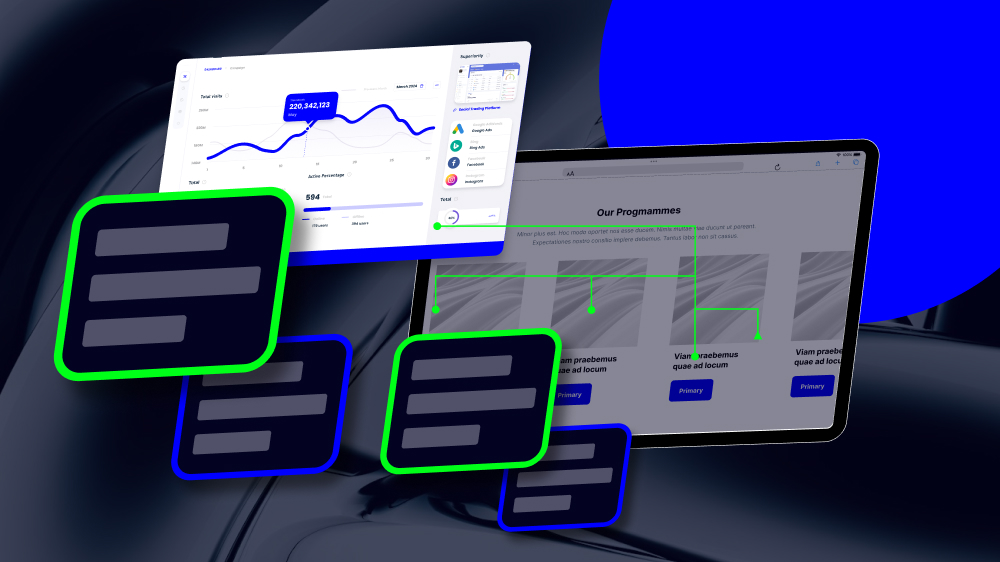12 Signs Your Organisation Needs a Digital Overhaul
Digital transformation is about rethinking how your organisation works, engages, and grows in a digital-first world. Staying current with technology is only one part of this. Ultimately, keeping competitive amongst constant digital change is key.
Over time, systems, strategies, and websites can fall behind evolving client expectations. Recognising the signs that your digital ecosystem needs an overhaul is the first step towards unlocking greater efficiency, performance, and growth.
Below are some clear signals that your organisation may need to rethink its digital presence.

Harry Hammett is a detail-driven Project Co-Ordinator at Itineris, ensuring seamless delivery across digital projects. With a keen eye for organisation and efficiency, he keeps teams aligned and clients informed, driving success through clear communication and meticulous planning.
1. Your Website No Longer Reflects Your Brand
Your website is often the first impression of your brand. It is also your most important digital asset, where all of your online channels point towards. Yet, many organisations rely on an outdated brand presence on their website.
Slow load times, dated design, and content bottlenecks all signal it’s time for an update.
A modern website should evolve with your organisation. It should empower your team to publish content quickly, integrate with your wider marketing tools, and deliver an experience that reflects who you are today, not who you were five years ago.
This does not mean a complete rebrand is necessary every five years. However, consistent brand enhancements to match the current market and your audience is important for maintaining relevance.
If your platform makes even small updates feel like hard work, it’s holding your brand back, which is also why having a scalable, user-friendly CMS is so important.
2. You’re Invisible Where it Matters Most
Despite ongoing changes in tech and search habits, search engines remain the primary route clients take to discover, research, and compare services. If your rankings have slipped or competitors are consistently outperforming you, then it’s a clear sign that your SEO strategy requires an update.
Modern search performance depends on far more than simply targeting keywords or maximising content output. It’s built on technical health, quality content, and a strong understanding of audience intent. Building a strong, holisitic brand presence across multiple channels is also key to gaining traction, as discoverability today is built around trust.
Prioritising SEO is investing in long-term visibility. Ultimately, if your organisation is not appearing where your audience is searching, then they will find someone else.
3. Paid Campaigns Aren’t Delivering ROI
Paid media needs to be measurable, accountable, and directly tied to outcomes. If your cost per lead is climbing while conversion rates fall, the issue likely isn’t budget, but alignment.
Campaigns perform best when they are data-led, integrated across channels, and constantly refined. From creative testing to audience segmentation and landing page optimisation, small inefficiencies can erode performance at a large scale.
Ultimately, the goal isn’t to gain more clicks, but to generate meaningful engagement that supports your wider business strategy.
This also emphasises the fact that paid media campaigns are only one part of a broader digital strategy and cannot operate effectively alone. Simply running ads is not enough to build a sustainable digital presence. Rather, you need to take a holistic approach to paid media to ensure every element of the client journey (from awareness to conversion) is fully optimised.
4. You’re Missing Clear Data Insights
Modern marketing relies on clear data insights. If you do not have easy access to quality data, then something needs to change.
If it takes hours to piece together performance reports or reconcile numbers between systems, your data infrastructure is working against you. Many businesses rely on multiple platforms that don’t speak to each other, leaving teams with conflicting insights and missed opportunities.
A unified view of performance, combining analytics, CRM, and campaign data, enables smarter, faster decisions. When you can see how every channel contributes to the bigger picture, you can identify what’s working, what’s wasted, and where to focus next.
Ideally, you should have access to custom data dashboards, allowing you to look past the generic metrics and gain insights that actually affect your online performance.
5. Your CMS is Limiting
Your content management system is the foundation of your digital presence, and so it should truly enable your team. This means it should be a springboard, and not a limitation.
If simple content updates require developer input or publishing takes longer than planning, you may have outgrown your platform. If your digital presence has grown and your legacy CMS struggles to keep up with the scale of your site, then it may be time to migrate your CMS.
Modern CMS options, like WordPress VIP, empower teams to manage content at scale, integrate with marketing tools, and maintain enterprise-grade performance and security. That’s not to mention the cost factor of choosing the right enterprise CMS.
For growing organisations, flexibility and ease of use are essential to staying agile and relevant. Your CMS is key to this.
6. Your Team is Stuck Doing Manual Work
Manual processes might feel manageable day-to-day, but over time they create friction and errors. Whether it’s exporting data between systems, maintaining duplicate spreadsheets, or managing leads manually, this hidden inefficiency adds up.
Automation and integration can transform productivity, not by replacing people, but by freeing them to focus on high-value work.
From automated campaign reporting to connected CRMs and workflows, technology should simplify complexity (not add to it).
7. Clients are Disengaging Online
Rising bounce rates, declining conversions, or low engagement are often symptoms of an experience that no longer meets your user’s expectations.
Audiences today expect fast, accessible, personalised interactions across devices and channels. A poor digital experience, whether it’s from slow performance, confusing navigation, or outdated creative, directly impacts perception and revenue.
Investing in user experience (UX) and continuous optimisation ensures every visit counts, turning passive browsers into active advocates.
In doing this, it’s important to take an approach focused on your specific users, and not just a generic idea of an online audience. This allows for a more refined UX that delivers stronger engagement.
8. Requirements for Stronger Security or Compliance
Security is one of the most essential factors for any enterprise website.
Outdated systems and inconsistent governance can leave your organisation exposed to unnecessary risk. From unpatched plugins to weak data protection measures, legacy technology often hides vulnerabilities that put your users, and your reputation, at stake.
Modern digital environments offer robust security, compliance features, and data controls as standard. Regular audits, encryption, and managed hosting reduce risk, while showing responsibility and building trust with every interaction.
Having a regular website maintenance and security monitoring plan in place is also key to maintaining a secure digital presence.
9. Growth Has Stalled Despite Effort
Many teams continue investing in campaigns, content, and technology long after results have plateaued. When growth slows despite a visible effort, it’s often a sign of disconnection between your strategy, systems, and goals.
True digital growth requires integration: a seamless connection between web performance, SEO, paid media, and analytics. Without it, your teams are running in parallel rather than pulling in the same direction.
A cohesive strategy aligns every channel around measurable outcomes, from lead generation to customer retention. In some cases, this can be achieved by a few small tweaks. In other cases, a total strategy readjustment is necessary. Either way, staying flexible and making changes in your digital planning is key to delivering sustained results.
10. You Don’t Have a Clear Digital Roadmap
Digital transformation about anticipating change, instead of reacting to it.
If every project feels like a one-off fix or a reaction to competitor moves, your business may be missing a long-term strategy.
A digital roadmap sets the direction by defining priorities, aligning technology with your commercial goals, and building a structure that supports growth. It turns digital investment into a continuous cycle of improvement rather than a series of short-term projects.
This also underscores the importance of taking a long-term digital mindset with a scalable foundation, instead of making large-scale changes over intervals. A long-term approach helps to maintain results and get the most value out of your digital investments, while establishing a process of continuous growth and improvement.
11. Accessibility Needs to be Enhanced
Accessibility is not simply a matter of ticking a compliance box. In practice, it’s fundamental to delivering inclusive, user-centred experiences that can enhance engagement, visibility, and overall digital performance. Yet, many organisations still overlook accessibility until it becomes a problem.
With 1 in 5 people in the UK having a disability, inaccessible design or content can exclude a significant portion of your audience and expose your organisation to legal and reputational risks. Barriers like poor colour contrast, missing alt text, or non-keyboard-friendly navigation can erode trust and engagement.
A digital overhaul is the opportunity to embed accessibility into every layer of your ecosystem, from design and content to testing and governance. When accessibility improves, usability improves for everyone.
12. A Growing Digital Footprint Requires Greater Scalability or Unity
As organisations expand, so do their digital ecosystems. This could include new microsites, campaign pages, regional domains, and content hubs. What starts as manageable quickly becomes fragmented.
Multiple platforms, inconsistent branding, and disconnected data systems lead to inefficiency and confusion. A scalable, unified architecture ensures your digital presence grows with you.
Whether it’s through multi-site frameworks, headless CMS setups, or shared design systems, consolidation brings order, reduces maintenance costs, and strengthens brand consistency.
Modern enterprises need digital platforms that can handle growth without creating silos. If your technology struggles to keep up with your plans, it’s time to rethink the foundations.
Enhance Your Digital Presence
Instead of seeing a digital overhaul as a one-time project, it should rather be a commitment to continuous improvement. The goal is to build a digital foundation that supports your brand’s growth now and adapts in the future.
At Itineris, we help ambitious organisations modernise, optimise, and scale their digital ecosystems for measurable impact. Get in touch with our team to discuss your next step.

